

Comparison of Several Metallized Fiber Production Methods
Oct,22,2023The optical fiber structure consists of three parts: core, cladding and coating. The schematic diagram of the optical fiber structure is shown in Figure 1. The refractive index of the core is greater than the refractive index of the cladding, and the core and cladding together form a waveguide structure. The coating layer is the protective layer of the optical fiber and can enhance the mechanical properties and bending resistance of the optical fiber. At present, the mainstream coating layers mainly include acrylic resin coating, heat-resistant silica gel coating and polyimide coating. Among them, acrylic resin-coated optical fiber is the most widely used, with an operating temperature of - 40 ~ 85 ℃; heat-resistant silica gel coating Optical fibers can be used stably for a long time in an air environment of 200 ℃, and at the same time, the attenuation added value and coating weight loss rate at high temperatures are low; polyimide-coated optical fibers can be used in an air atmosphere of 300 ℃ for a long time, and at 300 It can be used for a short period of time at ~ 400 ℃, and can also be used under high pressure and vacuum conditions. However, in higher operating temperatures and more severe operating environments, such as temperature sensing in marine environments and plasma diagnosis of thermonuclear reactors in the nuclear industry, organic coatings are no longer suitable, so higher temperature resistance is required. coating. Metals and alloys usually have higher melting points, and metal-coated optical fibers can be prepared to meet application requirements. Metal-coated optical fiber application areas include: temperature detection in high-temperature environments in metallurgical processes, sensing detection in high-temperature oil and gas wells, temperature detection in low-temperature environments, use in high vacuum or high-pressure environments, aerospace and shipbuilding fields, and engine sensors and fuel composition testing.

Fig. 1 Schematic diagram of optical fiber structure
The preparation methods of
metal-coated optical fibers are divided into chemical plating, electroplating,
sputtering, evaporation and molten metal methods, which will be introduced
separately below.
Method1:Chemical plating method
Electroless plating is a coating method that uses a reducing agent to reduce metal ions in a solution to deposit a metal coating on the surface of the workpiece. Due to the particularity of optical fiber materials, if you want to obtain a metal coating with excellent performance on the surface of the optical fiber, you need to pretreat the optical fiber. The pretreatment process of optical fiber includes removing protective layer, degreasing, roughening, sensitization and activation. These pretreatment processes can improve the ability of bare fiber surface to absorb metal and prepare its surface for further metallization. Pretreatment is a key step in the electroless plating process. The quality of the electroless plating coating largely depends on whether the pretreatment preparation is sufficient.
1. 1. 1 Remove the protective layer
The coating layer of optical fiber is usually acrylic resin, heat-resistant silicone, polyimide, etc., which needs to be removed before electroless plating. Removal methods can be divided into physical methods and chemical methods. The physical method is to use wire strippers or manual knives to strip the coating layer. This method is usually difficult to completely strip off the coating layer. Residues of the coating layer that are difficult to observe with the naked eye are easy to remain on the surface of the optical fiber, and the optical fiber itself is fragile and easily break. A method of combining multiple stripping and ultrasonic washing is used to obtain a bare fiber with a uniform and bright surface. Chemical methods use chemical reagents such as strong acids, strong bases and acetone to remove the coating through chemical reactions. The optical fiber coating can be effectively removed using chemical methods. After removal, the optical fiber surface will be smooth and will not cause damage to the optical fiber surface.
1. 1. 2 roughening
In order to enhance the bonding force between the optical fiber matrix and the metal coating, it is necessary to use strong acid or strong alkali to corrode the optical fiber surface so that the optical fiber surface has a certain roughness. Not roughening or the roughening time is too short [19-20] can easily lead to poor bonding force between the coating and the optical fiber surface; the roughening time is too long [21] can easily lead to optical
The fiber loss increases, and improper handling can easily lead to fiber breakage. Therefore, it is necessary to choose an appropriate roughening time to obtain a coating with strong bonding force and good morphology. After roughening, the complete silicon-oxygen tetrahedral structure on the surface of the optical fiber is damaged to a certain extent, causing it to easily form when the surface of the optical fiber comes into contact with water.Water film, so the researchers proposed that heat treatment can be used to remove the water film to enhance the bonding force and integrity of the coating.
1. 1. 3 Sensitization and activation
Sensitization treatment is to adsorb some easily oxidizable substances (sensitizers) on the surface of parts with certain adsorption capacity. Then during the activation treatment, the adsorbed sensitizer is oxidized and the activator is reduced to catalytic crystal nuclei, which are adsorbed on the surface. The surface of optical fiber provides necessary conditions for electroless plating. Electroless plating methods usually
Stannous chloride hydrochloric acid solution is used as a sensitizer to adsorb a layer of reducing divalent tin ions on the surface of the roughened optical fiber for activation treatment. Optical fiber electroless nickel plating usually uses palladium ion activation method. The purpose of activation is to reduce palladium ions into palladium and deposit them on the surface of the optical fiber in the form of granular particles.
surface, thus providing a nucleation and crystallization center for metal deposition on the optical fiber surface, allowing electroless nickel plating to proceed smoothly. Currently, there are many types of metals that can be applied to electroless plating, but nickel is still the most commonly used metal. The characteristics of electroless nickel plating include: uniform plating, high hardness, good wear and corrosion resistance, good weldability and electromagnetic shielding properties. Electroless plating is a convenient coating method, but the chemical reaction rate is usually difficult to control, resulting in the film being prepared with generally low precision. Therefore, this method is not feasible for devices that require precise control of thickness. The pretreatment process for optical fibers before chemical plating is complex, and removing the protective layer can easily cause the exposed optical fiber to break, making the test more difficult. The use of roughening processes to corrode the optical fiber surface can easily lead to a reduction in the mechanical properties of the optical fiber. Therefore, it is difficult to achieve long-distance continuous metal coating on the optical fiber surface using chemical plating. Even with the above shortcomings, electroless plating is still the most widely used method for preparing metal coatings on optical fiber surfaces.
Method 2:Electroplating method
Electroplating is a process that uses the principle of electrolysis to deposit a thin layer of metal or alloy on some solid surface. Electroplating uses a salt solution containing metal ions for the plating layer as the plating solution, and the conductive substrate to be plated as the cathode. Based on the action of electrolysis, the metal cations in the plating solution are deposited on the surface of the cathode to form a plating layer.
layer surface processing technology. Electroplating requires the parts to be plated to have a certain degree of conductivity. Therefore, when electroplating the surface of optical fibers, it is usually combined with methods such as chemical plating and magnetron sputtering. Among them, there are many studies on chemical plating combined with electroplating method, that is, using electroless plating method to plate a metal transition layer on the surface of the optical fiber, and then electroplating the same or different metal coatings. Currently, there are many types of metals that can be applied to electroplating. Researchers have prepared electroplated nickel, nickel-cobalt alloy, copper, zinc, tin and other metal coatings on the surface of optical fibers. Among them, nickel plating has been studied the most. The main components of the nickel plating bath determined by the study are nickel sulfate, nickel chloride, boric acid and sodium dodecyl sulfonate. The coating obtained by electroplating is mostly smooth and dense with fewer defects. Chemical plating combined with electroplating is a relatively mature metal coating preparation process. Compared with ordinary optical fiber sensors, the prepared optical fiber sensor has the advantages of small size, large measurement range, high measurement accuracy, convenient installation, solid structure and stable performance. The electroplating coating is thicker and can reach hundreds of microns. However, electroplating has the risk of plating solution contaminating the environment. The stress generated by electroplating and chemical plating can easily cause double or multiple peaks in the fiber grating resonance spectrum, serious band broadening and peak loss. Therefore, there is still room for improvement in the electroplating process. .
Method3:Sputtering method
The sputtering method uses positive ions generated by gas glow discharge to bombard the target at high speed under the action of an electric field under high pressure and high vacuum, so that the target atoms gain enough energy to escape from the target surface and deposit on the base material. A physical vapor deposition method on the surface. As technology continues to mature, the sputtering method has been developed. Magnetron sputtering coating not only has the characteristics of simple operation, no pollution to the environment and low-temperature sputtering, but also the prepared samples have excellent performance, the film structure is uniform and dense, and the film is consistent with The bonding strength of the base material is high. And the coating is not limited by materials. Almost any material can be sputtered. Some elements or compounds with high melting point and low vapor pressure can be plated by magnetron sputtering. It is easy to control the film thickness and the coating repeatability is good.
The disadvantages of this technology are that the equipment is expensive and needs to be carried out at high temperatures. The process is complex, the cost is high, the deposition rate is low, and the film layer is thin.
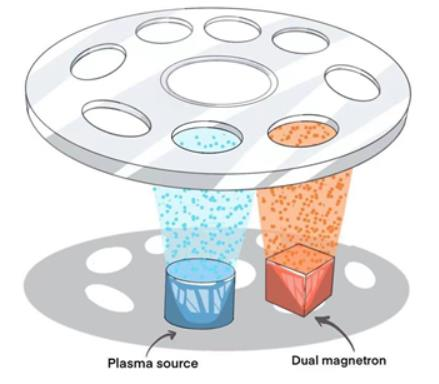

Fig. Magnetron Sputtering – MS Fig.The Fixture that we did to produce Metalized fiber
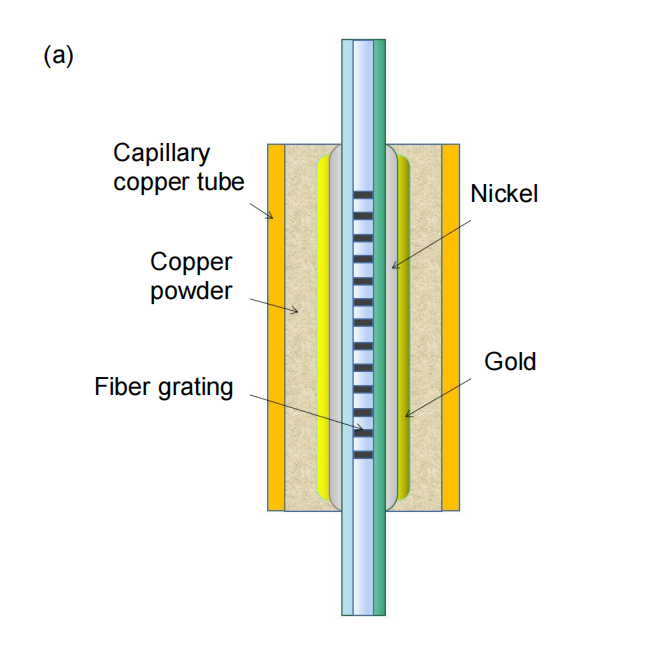
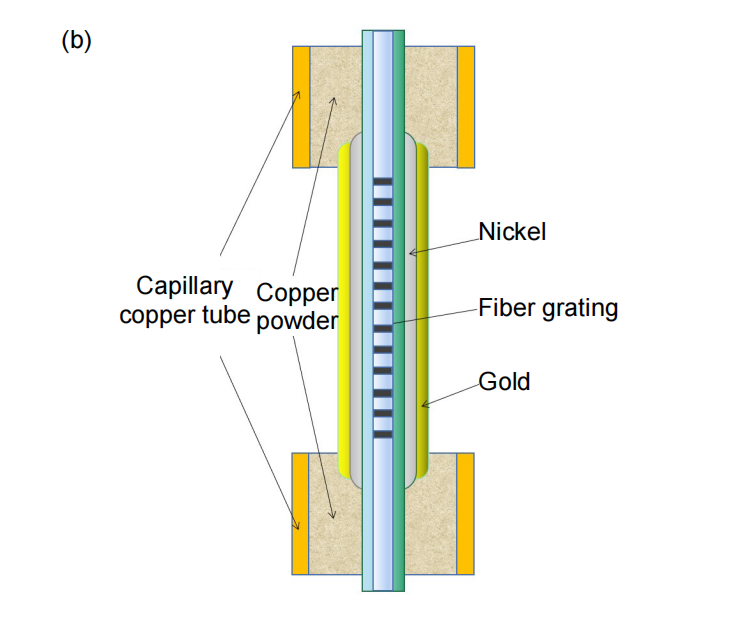
Fig. 1 The diagram of fiber grating sensor with metalized fiber
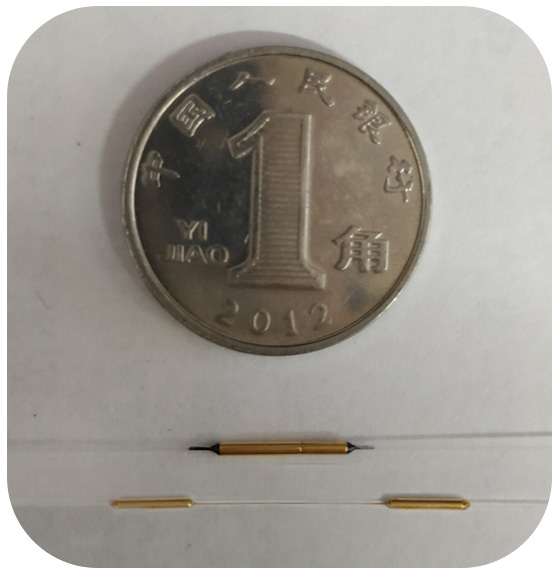
Fig. The physical photo of fiber bragger grateing sensors with metalized fiber
Method4:Evaporation method
The evaporation method is a method of depositing a thin film on a substrate by heating and evaporating the target material, or using electron beams to accelerate bombardment of the target material. Compared with electroplating and chemical plating, evaporation can produce a more uniform and denser film. The evaporation method has the advantages of high purity, good quality and accurate thickness of the coating.
It has the advantages of control, but there are problems such as poor process repeatability, low coating adhesion and large amount of consumables during the evaporation process.

Fig. Ion Assisted Deposition – IAD
Method5:Molten metal method
The molten metal method refers to the method of directly coating a layer of metal on the surface of the optical fiber by passing the optical fiber through the molten metal liquid. The molten metal method has the characteristics of simple operation, low cost, fast coating speed and strong production capacity. Compared with the above methods, the biggest advantage of the molten metal method is that
In this way, only metal coating can be realized during the fiber drawing process. The online coating device is shown in Figure 2.
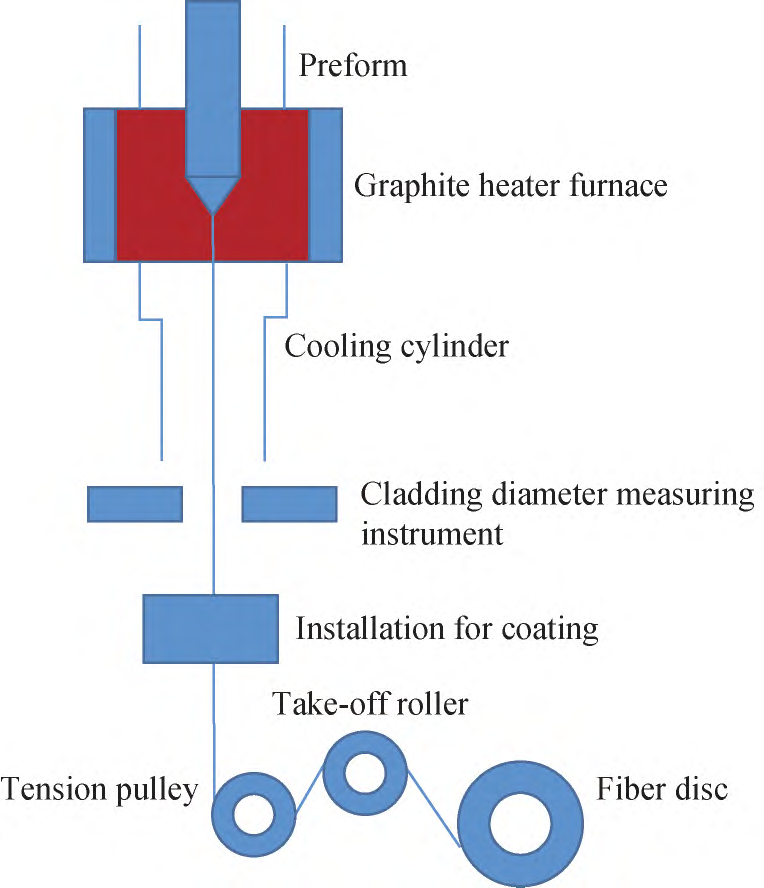
Fig. Schematic diagram of on-line metal coating device
Optical fiber metallization technology and vacuum evaporation coating technology are relatively mature. Using vapor deposition technology, the metal to be plated is evaporated through resistance wire heating. The metal vapor is condensed when encountering low-temperature materials. The film formation method is simple, the film purity and density are high, and the film formation structure and performance are excellent. This technology is relatively mature. But the coating thickness cannot be controlled. Magnetron sputtering technology uses high pressure and vacuum to ionize the sputtered gas. The positively charged ions bombard the metal to be plated under the action of the electric field, causing some surface atoms or molecules to be bombarded and deposited on the plated parts. In sputtering technology, the electron kinetic energy is much larger than that of evaporation, so the film formation is dense and pure, and the thickness of the film can be controlled by controlling the sputtering time. Chemical plating technology is to plate the metal to be plated on the plated parts through chemical reactions. The principle of this technology is simple, but it is gradually being replaced by evaporation and sputtering technologies.
-------------------------------------------------------------------------------------------------------------
About Hennan Omeda Technologies Co.,Ltd
Omeda is a company that focuses on the production of advanced optical and semiconductor components. Our team consists of several PhDs who study optical components and semiconductor component processing. We have extensive experience in glass molding technology,glass polishing technology, through-silicon via and through-glass via technology, optical coating technology, optical fiber device technology, lithography technology,Nanoimprint technology, free-form surface, metasurface and diffractive optical design.
Our business involved in Lidar,consumer electronics,Biomedical,3D Sensing, AR,VR,fiber communication,Laser Projection and Display,high power laser and so on. We provide advanced optical and semicondutor components for clients to make their design become real products.
Email:omedaoptics@gmail.com
Tel/Whatsapp:+86 151 1838 3837